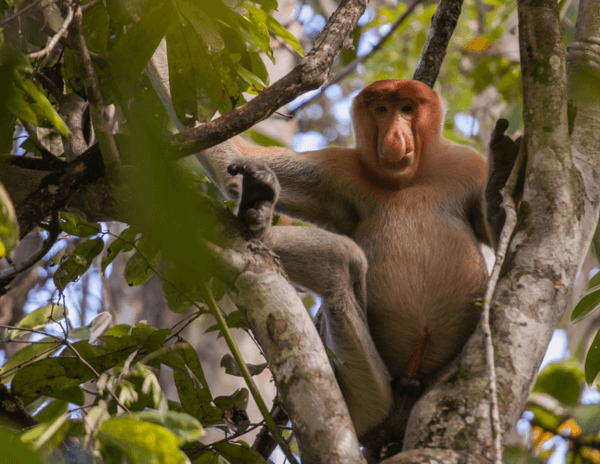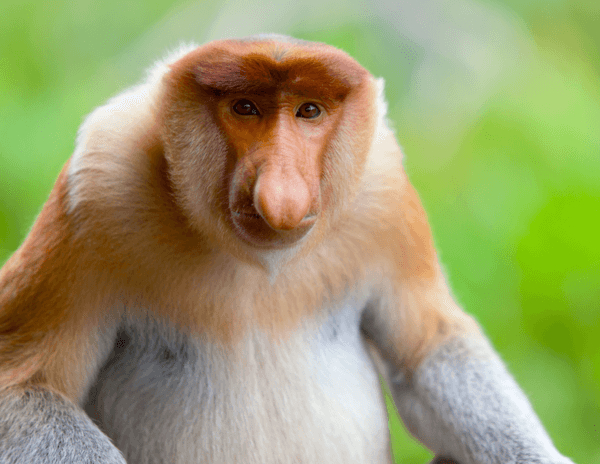When you think of East Kalimantan, the first images that might come to mind are the lush rainforests, winding rivers, and rich cultural heritage. However, one of the most fascinating and unique inhabitants of this region is the, a primate that captivates the imagination with its distinctive appearance and intriguing behaviour.
If you follow Kaltimber’s blogs, you know that there are many other animals endemic to Kalimantan such as Orangutans and Sunbears. Today, we focus on the Proboscis Monkey.
The Iconic Resident of Borneo: The Proboscis Monkey
In the 1968 episode "Flight 714" of the classic comic series *The Adventures of Tintin*There's a funny moment where the character Allan glances at a uniquely long-nosed monkey and imagines it to be his boss, Rastapopoulos.
The Proboscis monkey, or *Nasalis larvatus*, is an extraordinary primate native to the island of Borneo, including the Indonesian region of East Kalimantan. These monkeys are instantly recognizable by their unusually large noses, which are particularly pronounced in males. While their nose might seem a bit exaggerated, it’s actually a key part of their identity, believed to help with vocalisations and attracting mates.
Proboscis monkeys are also known for their reddish-brown fur, pot-bellied appearance, and webbed feet, which make them excellent swimmers—a unique trait among primates. These monkeys often dwell in the mangrove forests, swamps, and riverine areas of East Kalimantan, where they have adapted perfectly to their environment.
Habitat and Behavior: Life Along the Mangroves
East Kalimantan's rich mangrove forests provide the perfect habitat for the Proboscis monkeys. These areas are teeming with life, offering a variety of fruits, seeds, and leaves that make up the diet of these monkeys. They are often seen moving gracefully through the trees, using their long limbs to navigate the dense vegetation, or taking a dip in the river—a skill they’ve mastered thanks to their webbed feet.
Proboscis monkeys live in social groups, typically consisting of one dominant male and several females with their offspring. These groups are highly territorial, often found close to rivers, where they sleep in trees along the banks. As dusk falls, you might witness them gathering on tree branches by the river, preparing for the night. Their loud honking calls can be heard echoing through the forest, a sound that is both a warning to rivals and a way to keep the group together.
Conservation Status: A Species at Risk
Despite their strong adaptation to their environment, Proboscis monkeys are listed as endangered, mainly due to habitat loss caused by deforestation, palm oil plantations, and human encroachment. In East Kalimantan, conservation efforts are crucial to protect these remarkable creatures and their natural habitats. This threat is highlighted by the construction of Indonesia’s new capital, Nusantara.
Several conservation programs are in place to help preserve the remaining populations of Proboscis monkeys. These efforts include protecting their habitats, enforcing laws against hunting, and promoting sustainable land-use practices. Ecotourism also plays a vital role, offering visitors the chance to see these monkeys in their natural environment while contributing to local conservation initiatives.
Ecotourism and Responsible Travel
For those lucky enough to visit East Kalimantan, encountering the Proboscis monkeys in their natural habitat is an unforgettable experience. Tours often take visitors through the mangrove forests by boat, where the monkeys can be observed in the wild. This not only provides a unique opportunity to see these fascinating animals up close but also helps raise awareness about their plight and the importance of conservation.
As ecotourism grows in the region, it’s important for travellers to choose responsible tour operators who prioritise the welfare of wildlife and the environment. By supporting such initiatives, visitors can play a part in ensuring that future generations will also have the chance to witness the beauty and diversity of East Kalimantan’s wildlife.
A Unique Encounter with East Kalimantan’s Wild Side
The Proboscis monkeys of East Kalimantan are more than just an exotic species; they are a symbol of the island’s incredible biodiversity and the delicate balance that exists within its ecosystems. Protecting these unique primates is essential not only for preserving the species but also for maintaining the health of the mangrove forests they call home.
As you explore East Kalimantan, remember that every encounter with its wildlife is a reminder of the natural wonders that need our protection. The Proboscis monkey, with its endearing looks and fascinating behaviour, is a reminder of the unique beauty that can only be found in the wilds of Borneo.





